Finance for Managers: Recording, Budgeting, and Appraisal
VerifiedAdded on 2020/01/21
|19
|5560
|89
Report
AI Summary
This report, created for a Finance for Managers course, delves into key aspects of financial management within a business context. It begins by exploring the importance of financial records, different methods for recording financial data (including income statements, balance sheets, and cash flow statements), and the legal and organizational needs for financial recording. The report then analyzes the use of financial statements by stakeholders and differentiates between financial and management accounting. A significant portion is dedicated to budgetary control, outlining the process and its various steps, including revenue and cost projections, profit margin analysis, board approval, and budget review. The report further examines variance calculation and interpretation, various project appraisal techniques, and methods for securing funds for business projects. It concludes by discussing the elements of working capital and effective management strategies. The report provides a comprehensive overview of financial principles and practices relevant to managerial decision-making.
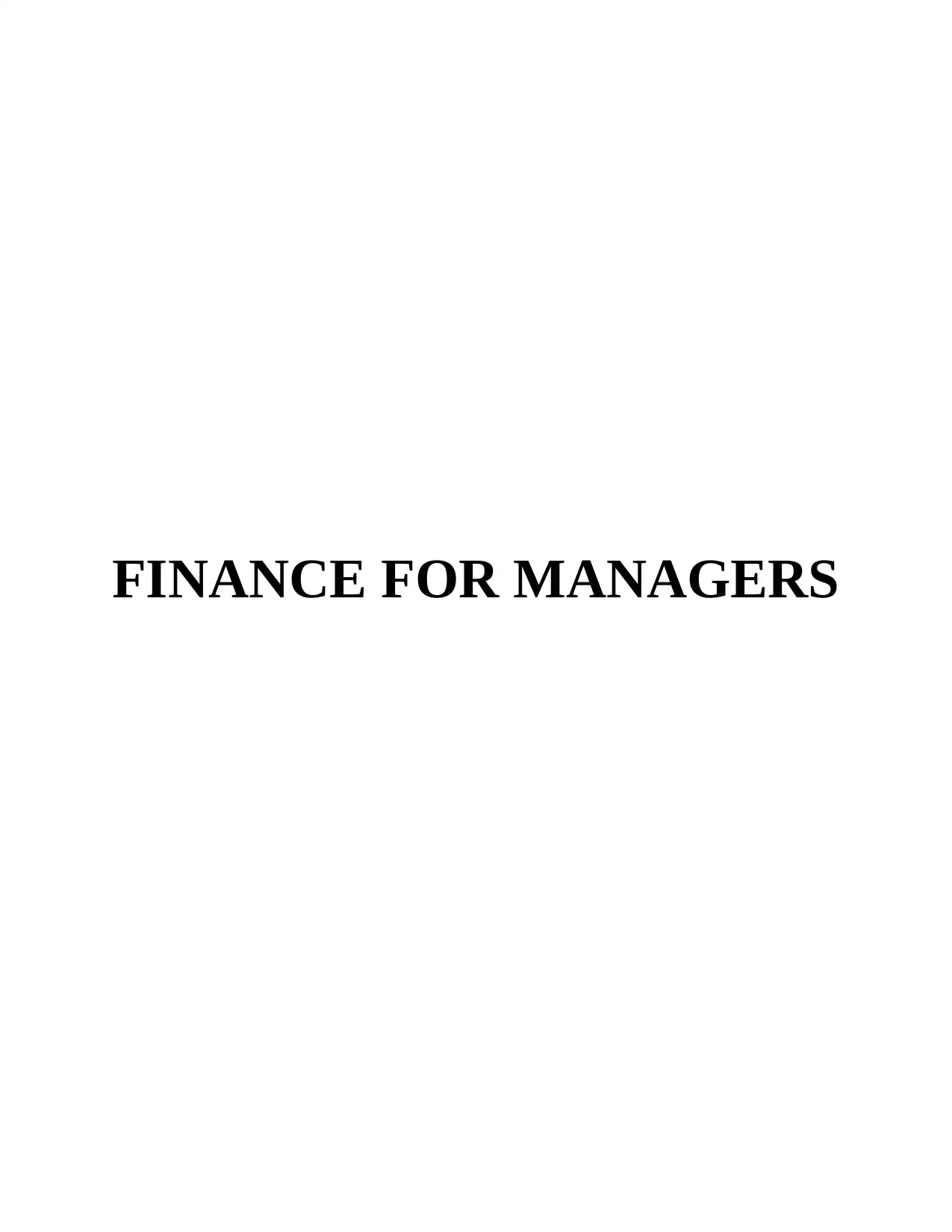
FINANCE FOR MANAGERS
Paraphrase This Document
Need a fresh take? Get an instant paraphrase of this document with our AI Paraphraser
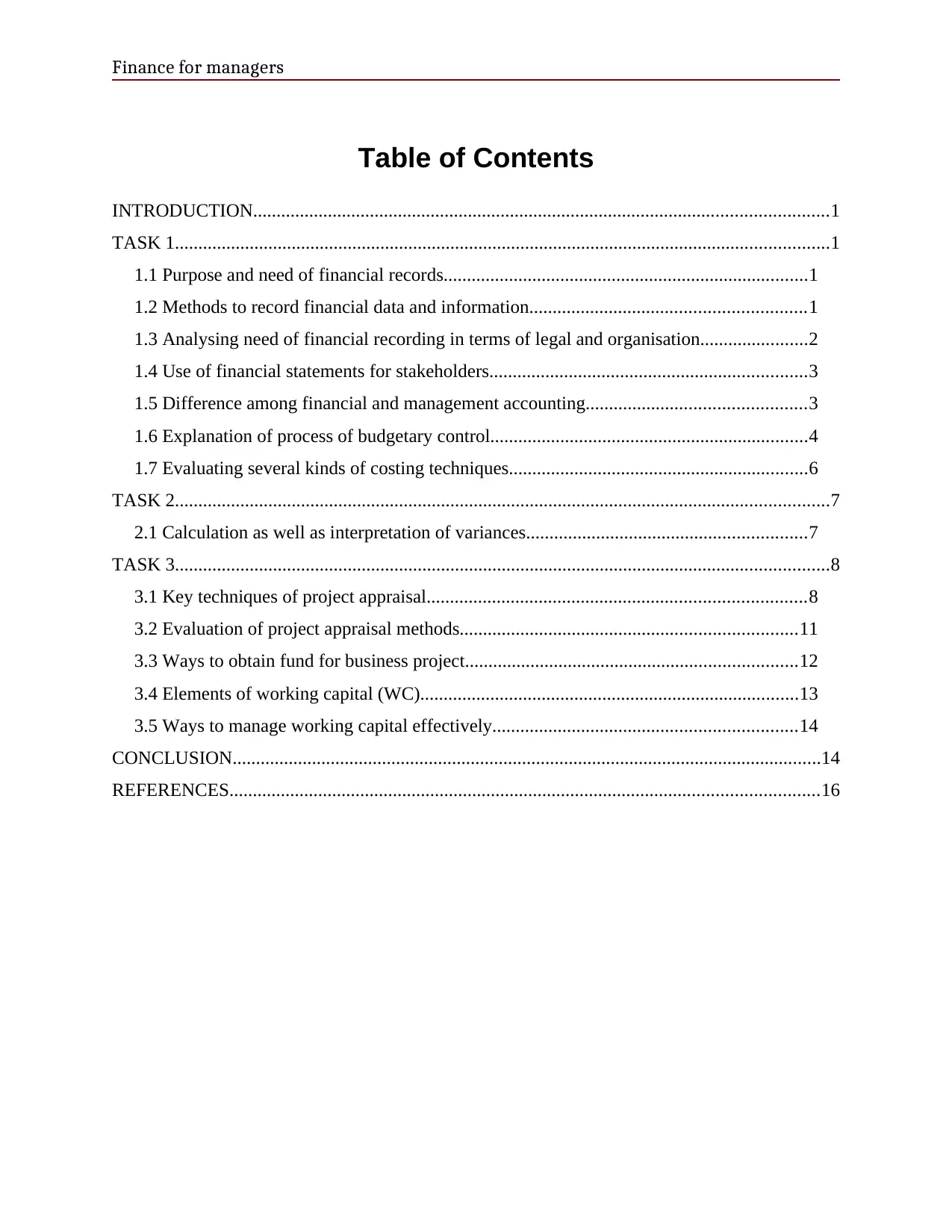
Finance for managers
Table of Contents
INTRODUCTION...........................................................................................................................1
TASK 1............................................................................................................................................1
1.1 Purpose and need of financial records..............................................................................1
1.2 Methods to record financial data and information...........................................................1
1.3 Analysing need of financial recording in terms of legal and organisation.......................2
1.4 Use of financial statements for stakeholders....................................................................3
1.5 Difference among financial and management accounting...............................................3
1.6 Explanation of process of budgetary control....................................................................4
1.7 Evaluating several kinds of costing techniques................................................................6
TASK 2............................................................................................................................................7
2.1 Calculation as well as interpretation of variances............................................................7
TASK 3............................................................................................................................................8
3.1 Key techniques of project appraisal.................................................................................8
3.2 Evaluation of project appraisal methods........................................................................11
3.3 Ways to obtain fund for business project.......................................................................12
3.4 Elements of working capital (WC).................................................................................13
3.5 Ways to manage working capital effectively.................................................................14
CONCLUSION..............................................................................................................................14
REFERENCES..............................................................................................................................16
Table of Contents
INTRODUCTION...........................................................................................................................1
TASK 1............................................................................................................................................1
1.1 Purpose and need of financial records..............................................................................1
1.2 Methods to record financial data and information...........................................................1
1.3 Analysing need of financial recording in terms of legal and organisation.......................2
1.4 Use of financial statements for stakeholders....................................................................3
1.5 Difference among financial and management accounting...............................................3
1.6 Explanation of process of budgetary control....................................................................4
1.7 Evaluating several kinds of costing techniques................................................................6
TASK 2............................................................................................................................................7
2.1 Calculation as well as interpretation of variances............................................................7
TASK 3............................................................................................................................................8
3.1 Key techniques of project appraisal.................................................................................8
3.2 Evaluation of project appraisal methods........................................................................11
3.3 Ways to obtain fund for business project.......................................................................12
3.4 Elements of working capital (WC).................................................................................13
3.5 Ways to manage working capital effectively.................................................................14
CONCLUSION..............................................................................................................................14
REFERENCES..............................................................................................................................16
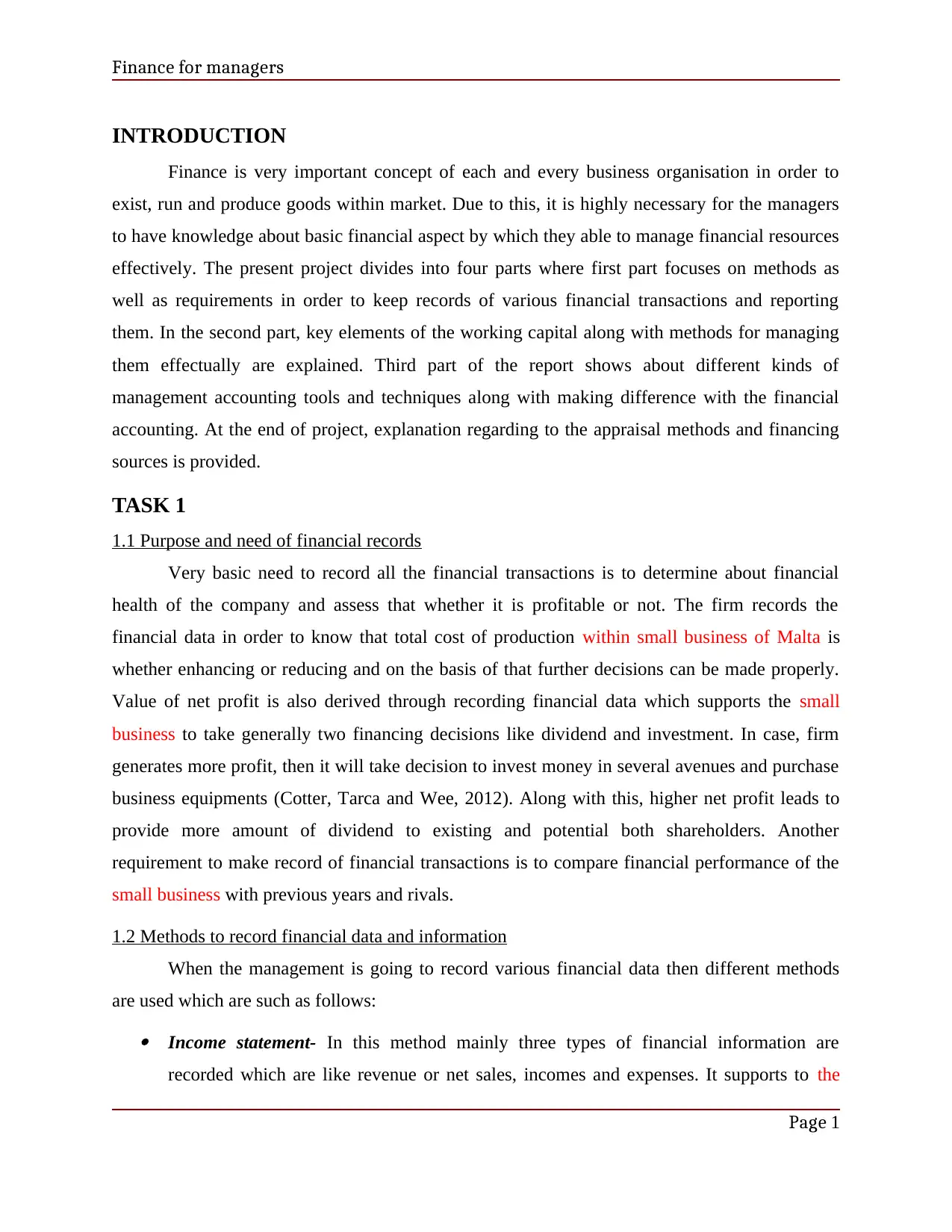
Finance for managers
INTRODUCTION
Finance is very important concept of each and every business organisation in order to
exist, run and produce goods within market. Due to this, it is highly necessary for the managers
to have knowledge about basic financial aspect by which they able to manage financial resources
effectively. The present project divides into four parts where first part focuses on methods as
well as requirements in order to keep records of various financial transactions and reporting
them. In the second part, key elements of the working capital along with methods for managing
them effectually are explained. Third part of the report shows about different kinds of
management accounting tools and techniques along with making difference with the financial
accounting. At the end of project, explanation regarding to the appraisal methods and financing
sources is provided.
TASK 1
1.1 Purpose and need of financial records
Very basic need to record all the financial transactions is to determine about financial
health of the company and assess that whether it is profitable or not. The firm records the
financial data in order to know that total cost of production within small business of Malta is
whether enhancing or reducing and on the basis of that further decisions can be made properly.
Value of net profit is also derived through recording financial data which supports the small
business to take generally two financing decisions like dividend and investment. In case, firm
generates more profit, then it will take decision to invest money in several avenues and purchase
business equipments (Cotter, Tarca and Wee, 2012). Along with this, higher net profit leads to
provide more amount of dividend to existing and potential both shareholders. Another
requirement to make record of financial transactions is to compare financial performance of the
small business with previous years and rivals.
1.2 Methods to record financial data and information
When the management is going to record various financial data then different methods
are used which are such as follows: Income statement- In this method mainly three types of financial information are
recorded which are like revenue or net sales, incomes and expenses. It supports to the
Page 1
INTRODUCTION
Finance is very important concept of each and every business organisation in order to
exist, run and produce goods within market. Due to this, it is highly necessary for the managers
to have knowledge about basic financial aspect by which they able to manage financial resources
effectively. The present project divides into four parts where first part focuses on methods as
well as requirements in order to keep records of various financial transactions and reporting
them. In the second part, key elements of the working capital along with methods for managing
them effectually are explained. Third part of the report shows about different kinds of
management accounting tools and techniques along with making difference with the financial
accounting. At the end of project, explanation regarding to the appraisal methods and financing
sources is provided.
TASK 1
1.1 Purpose and need of financial records
Very basic need to record all the financial transactions is to determine about financial
health of the company and assess that whether it is profitable or not. The firm records the
financial data in order to know that total cost of production within small business of Malta is
whether enhancing or reducing and on the basis of that further decisions can be made properly.
Value of net profit is also derived through recording financial data which supports the small
business to take generally two financing decisions like dividend and investment. In case, firm
generates more profit, then it will take decision to invest money in several avenues and purchase
business equipments (Cotter, Tarca and Wee, 2012). Along with this, higher net profit leads to
provide more amount of dividend to existing and potential both shareholders. Another
requirement to make record of financial transactions is to compare financial performance of the
small business with previous years and rivals.
1.2 Methods to record financial data and information
When the management is going to record various financial data then different methods
are used which are such as follows: Income statement- In this method mainly three types of financial information are
recorded which are like revenue or net sales, incomes and expenses. It supports to the
Page 1
⊘ This is a preview!⊘
Do you want full access?
Subscribe today to unlock all pages.

Trusted by 1+ million students worldwide
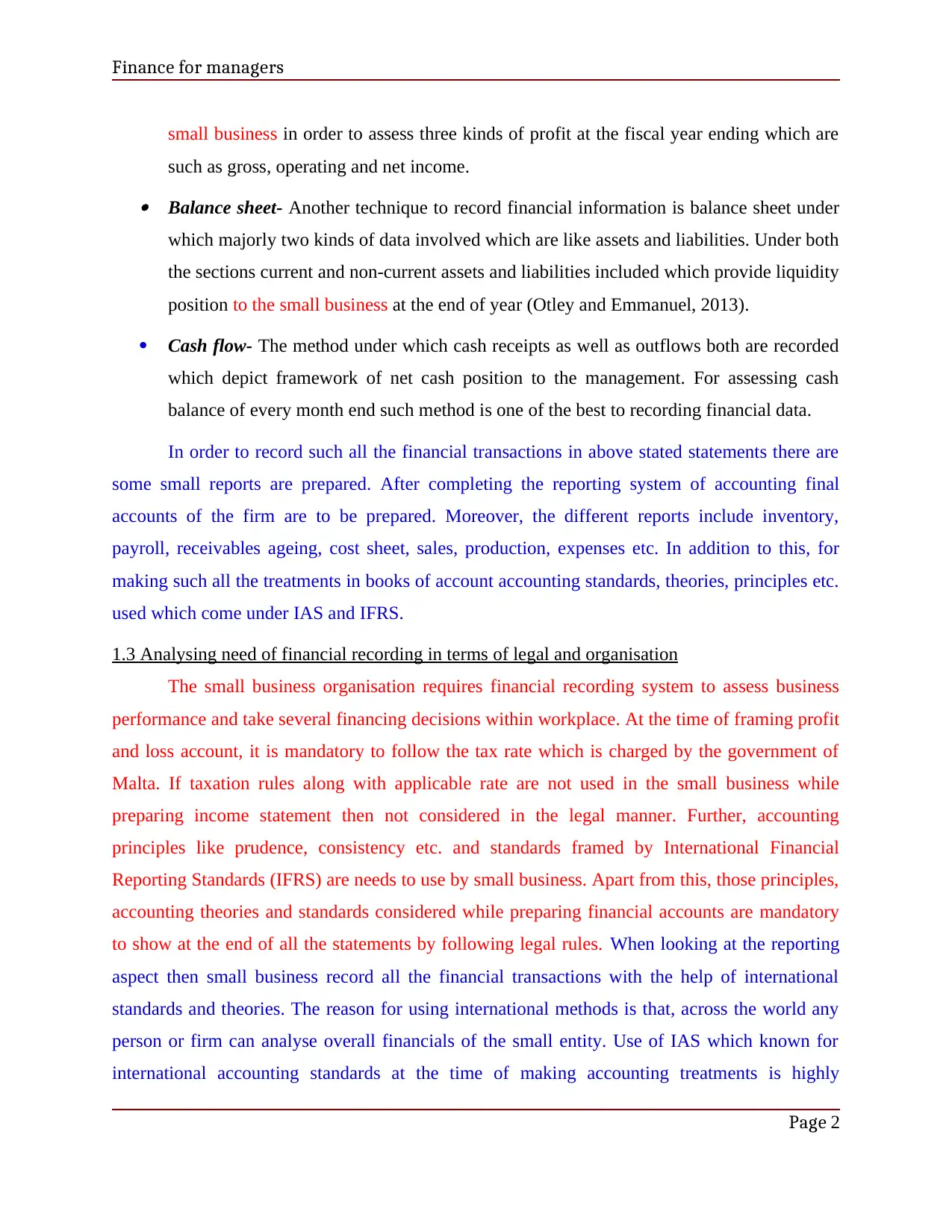
Finance for managers
small business in order to assess three kinds of profit at the fiscal year ending which are
such as gross, operating and net income. Balance sheet- Another technique to record financial information is balance sheet under
which majorly two kinds of data involved which are like assets and liabilities. Under both
the sections current and non-current assets and liabilities included which provide liquidity
position to the small business at the end of year (Otley and Emmanuel, 2013).
Cash flow- The method under which cash receipts as well as outflows both are recorded
which depict framework of net cash position to the management. For assessing cash
balance of every month end such method is one of the best to recording financial data.
In order to record such all the financial transactions in above stated statements there are
some small reports are prepared. After completing the reporting system of accounting final
accounts of the firm are to be prepared. Moreover, the different reports include inventory,
payroll, receivables ageing, cost sheet, sales, production, expenses etc. In addition to this, for
making such all the treatments in books of account accounting standards, theories, principles etc.
used which come under IAS and IFRS.
1.3 Analysing need of financial recording in terms of legal and organisation
The small business organisation requires financial recording system to assess business
performance and take several financing decisions within workplace. At the time of framing profit
and loss account, it is mandatory to follow the tax rate which is charged by the government of
Malta. If taxation rules along with applicable rate are not used in the small business while
preparing income statement then not considered in the legal manner. Further, accounting
principles like prudence, consistency etc. and standards framed by International Financial
Reporting Standards (IFRS) are needs to use by small business. Apart from this, those principles,
accounting theories and standards considered while preparing financial accounts are mandatory
to show at the end of all the statements by following legal rules. When looking at the reporting
aspect then small business record all the financial transactions with the help of international
standards and theories. The reason for using international methods is that, across the world any
person or firm can analyse overall financials of the small entity. Use of IAS which known for
international accounting standards at the time of making accounting treatments is highly
Page 2
small business in order to assess three kinds of profit at the fiscal year ending which are
such as gross, operating and net income. Balance sheet- Another technique to record financial information is balance sheet under
which majorly two kinds of data involved which are like assets and liabilities. Under both
the sections current and non-current assets and liabilities included which provide liquidity
position to the small business at the end of year (Otley and Emmanuel, 2013).
Cash flow- The method under which cash receipts as well as outflows both are recorded
which depict framework of net cash position to the management. For assessing cash
balance of every month end such method is one of the best to recording financial data.
In order to record such all the financial transactions in above stated statements there are
some small reports are prepared. After completing the reporting system of accounting final
accounts of the firm are to be prepared. Moreover, the different reports include inventory,
payroll, receivables ageing, cost sheet, sales, production, expenses etc. In addition to this, for
making such all the treatments in books of account accounting standards, theories, principles etc.
used which come under IAS and IFRS.
1.3 Analysing need of financial recording in terms of legal and organisation
The small business organisation requires financial recording system to assess business
performance and take several financing decisions within workplace. At the time of framing profit
and loss account, it is mandatory to follow the tax rate which is charged by the government of
Malta. If taxation rules along with applicable rate are not used in the small business while
preparing income statement then not considered in the legal manner. Further, accounting
principles like prudence, consistency etc. and standards framed by International Financial
Reporting Standards (IFRS) are needs to use by small business. Apart from this, those principles,
accounting theories and standards considered while preparing financial accounts are mandatory
to show at the end of all the statements by following legal rules. When looking at the reporting
aspect then small business record all the financial transactions with the help of international
standards and theories. The reason for using international methods is that, across the world any
person or firm can analyse overall financials of the small entity. Use of IAS which known for
international accounting standards at the time of making accounting treatments is highly
Page 2
Paraphrase This Document
Need a fresh take? Get an instant paraphrase of this document with our AI Paraphraser
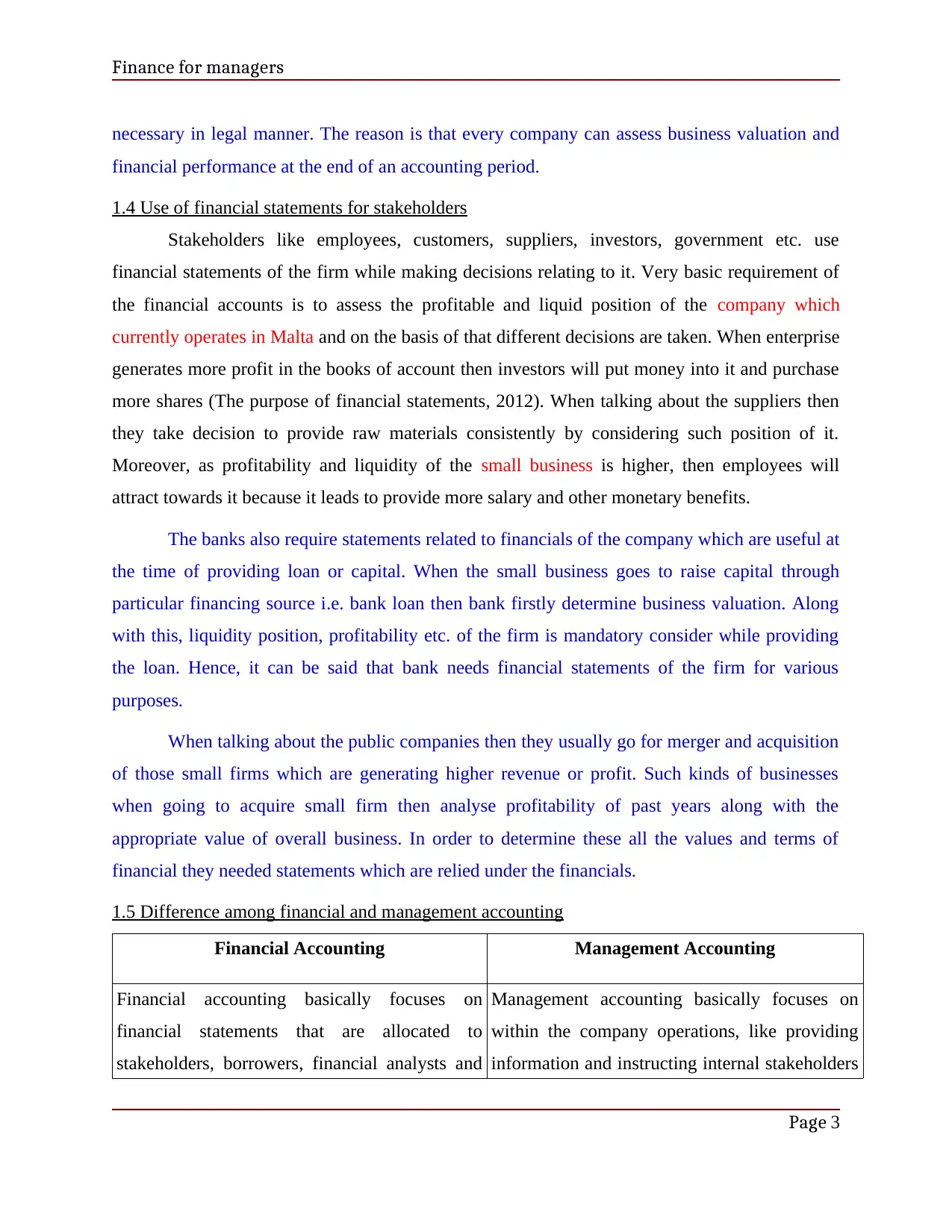
Finance for managers
necessary in legal manner. The reason is that every company can assess business valuation and
financial performance at the end of an accounting period.
1.4 Use of financial statements for stakeholders
Stakeholders like employees, customers, suppliers, investors, government etc. use
financial statements of the firm while making decisions relating to it. Very basic requirement of
the financial accounts is to assess the profitable and liquid position of the company which
currently operates in Malta and on the basis of that different decisions are taken. When enterprise
generates more profit in the books of account then investors will put money into it and purchase
more shares (The purpose of financial statements, 2012). When talking about the suppliers then
they take decision to provide raw materials consistently by considering such position of it.
Moreover, as profitability and liquidity of the small business is higher, then employees will
attract towards it because it leads to provide more salary and other monetary benefits.
The banks also require statements related to financials of the company which are useful at
the time of providing loan or capital. When the small business goes to raise capital through
particular financing source i.e. bank loan then bank firstly determine business valuation. Along
with this, liquidity position, profitability etc. of the firm is mandatory consider while providing
the loan. Hence, it can be said that bank needs financial statements of the firm for various
purposes.
When talking about the public companies then they usually go for merger and acquisition
of those small firms which are generating higher revenue or profit. Such kinds of businesses
when going to acquire small firm then analyse profitability of past years along with the
appropriate value of overall business. In order to determine these all the values and terms of
financial they needed statements which are relied under the financials.
1.5 Difference among financial and management accounting
Financial Accounting Management Accounting
Financial accounting basically focuses on
financial statements that are allocated to
stakeholders, borrowers, financial analysts and
Management accounting basically focuses on
within the company operations, like providing
information and instructing internal stakeholders
Page 3
necessary in legal manner. The reason is that every company can assess business valuation and
financial performance at the end of an accounting period.
1.4 Use of financial statements for stakeholders
Stakeholders like employees, customers, suppliers, investors, government etc. use
financial statements of the firm while making decisions relating to it. Very basic requirement of
the financial accounts is to assess the profitable and liquid position of the company which
currently operates in Malta and on the basis of that different decisions are taken. When enterprise
generates more profit in the books of account then investors will put money into it and purchase
more shares (The purpose of financial statements, 2012). When talking about the suppliers then
they take decision to provide raw materials consistently by considering such position of it.
Moreover, as profitability and liquidity of the small business is higher, then employees will
attract towards it because it leads to provide more salary and other monetary benefits.
The banks also require statements related to financials of the company which are useful at
the time of providing loan or capital. When the small business goes to raise capital through
particular financing source i.e. bank loan then bank firstly determine business valuation. Along
with this, liquidity position, profitability etc. of the firm is mandatory consider while providing
the loan. Hence, it can be said that bank needs financial statements of the firm for various
purposes.
When talking about the public companies then they usually go for merger and acquisition
of those small firms which are generating higher revenue or profit. Such kinds of businesses
when going to acquire small firm then analyse profitability of past years along with the
appropriate value of overall business. In order to determine these all the values and terms of
financial they needed statements which are relied under the financials.
1.5 Difference among financial and management accounting
Financial Accounting Management Accounting
Financial accounting basically focuses on
financial statements that are allocated to
stakeholders, borrowers, financial analysts and
Management accounting basically focuses on
within the company operations, like providing
information and instructing internal stakeholders
Page 3
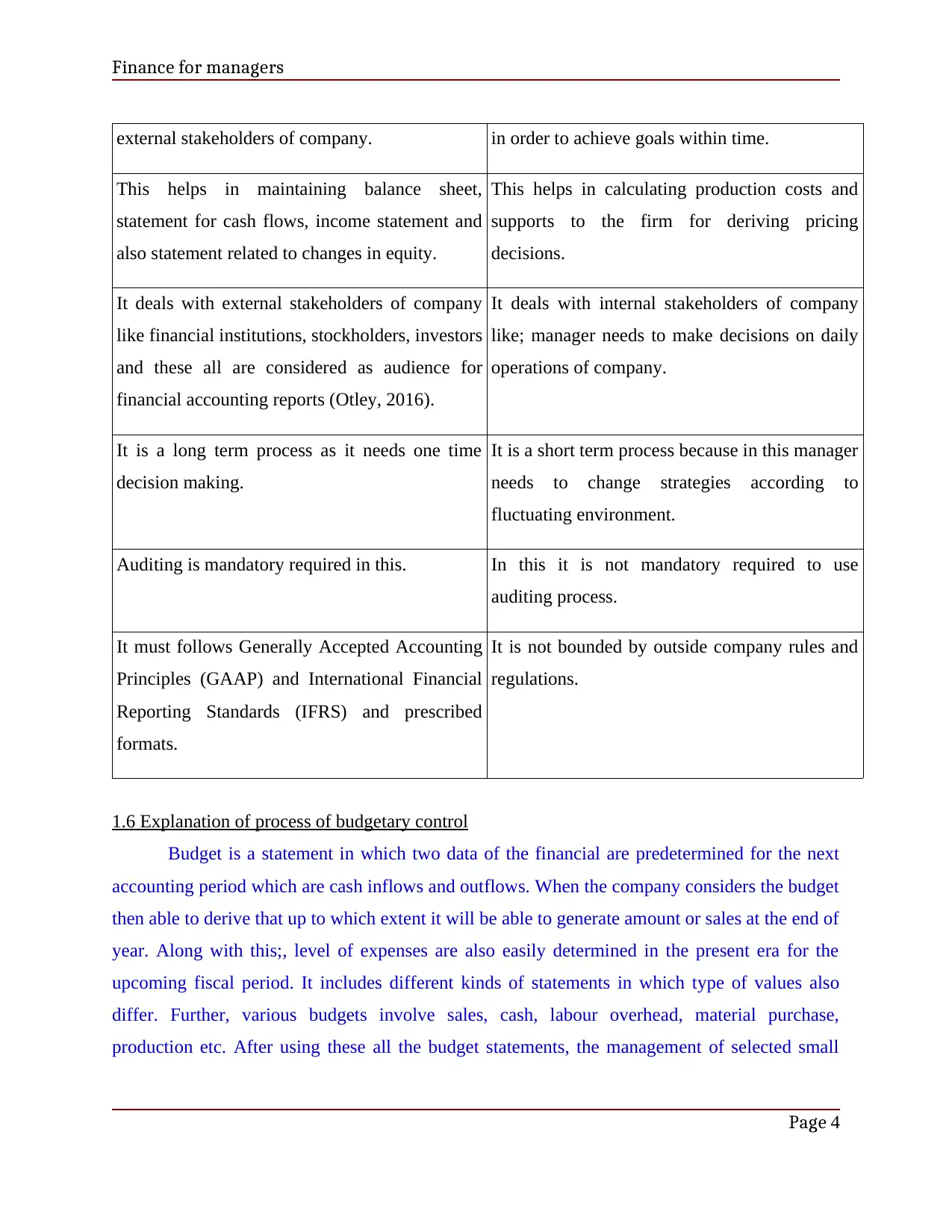
Finance for managers
external stakeholders of company. in order to achieve goals within time.
This helps in maintaining balance sheet,
statement for cash flows, income statement and
also statement related to changes in equity.
This helps in calculating production costs and
supports to the firm for deriving pricing
decisions.
It deals with external stakeholders of company
like financial institutions, stockholders, investors
and these all are considered as audience for
financial accounting reports (Otley, 2016).
It deals with internal stakeholders of company
like; manager needs to make decisions on daily
operations of company.
It is a long term process as it needs one time
decision making.
It is a short term process because in this manager
needs to change strategies according to
fluctuating environment.
Auditing is mandatory required in this. In this it is not mandatory required to use
auditing process.
It must follows Generally Accepted Accounting
Principles (GAAP) and International Financial
Reporting Standards (IFRS) and prescribed
formats.
It is not bounded by outside company rules and
regulations.
1.6 Explanation of process of budgetary control
Budget is a statement in which two data of the financial are predetermined for the next
accounting period which are cash inflows and outflows. When the company considers the budget
then able to derive that up to which extent it will be able to generate amount or sales at the end of
year. Along with this;, level of expenses are also easily determined in the present era for the
upcoming fiscal period. It includes different kinds of statements in which type of values also
differ. Further, various budgets involve sales, cash, labour overhead, material purchase,
production etc. After using these all the budget statements, the management of selected small
Page 4
external stakeholders of company. in order to achieve goals within time.
This helps in maintaining balance sheet,
statement for cash flows, income statement and
also statement related to changes in equity.
This helps in calculating production costs and
supports to the firm for deriving pricing
decisions.
It deals with external stakeholders of company
like financial institutions, stockholders, investors
and these all are considered as audience for
financial accounting reports (Otley, 2016).
It deals with internal stakeholders of company
like; manager needs to make decisions on daily
operations of company.
It is a long term process as it needs one time
decision making.
It is a short term process because in this manager
needs to change strategies according to
fluctuating environment.
Auditing is mandatory required in this. In this it is not mandatory required to use
auditing process.
It must follows Generally Accepted Accounting
Principles (GAAP) and International Financial
Reporting Standards (IFRS) and prescribed
formats.
It is not bounded by outside company rules and
regulations.
1.6 Explanation of process of budgetary control
Budget is a statement in which two data of the financial are predetermined for the next
accounting period which are cash inflows and outflows. When the company considers the budget
then able to derive that up to which extent it will be able to generate amount or sales at the end of
year. Along with this;, level of expenses are also easily determined in the present era for the
upcoming fiscal period. It includes different kinds of statements in which type of values also
differ. Further, various budgets involve sales, cash, labour overhead, material purchase,
production etc. After using these all the budget statements, the management of selected small
Page 4
⊘ This is a preview!⊘
Do you want full access?
Subscribe today to unlock all pages.

Trusted by 1+ million students worldwide
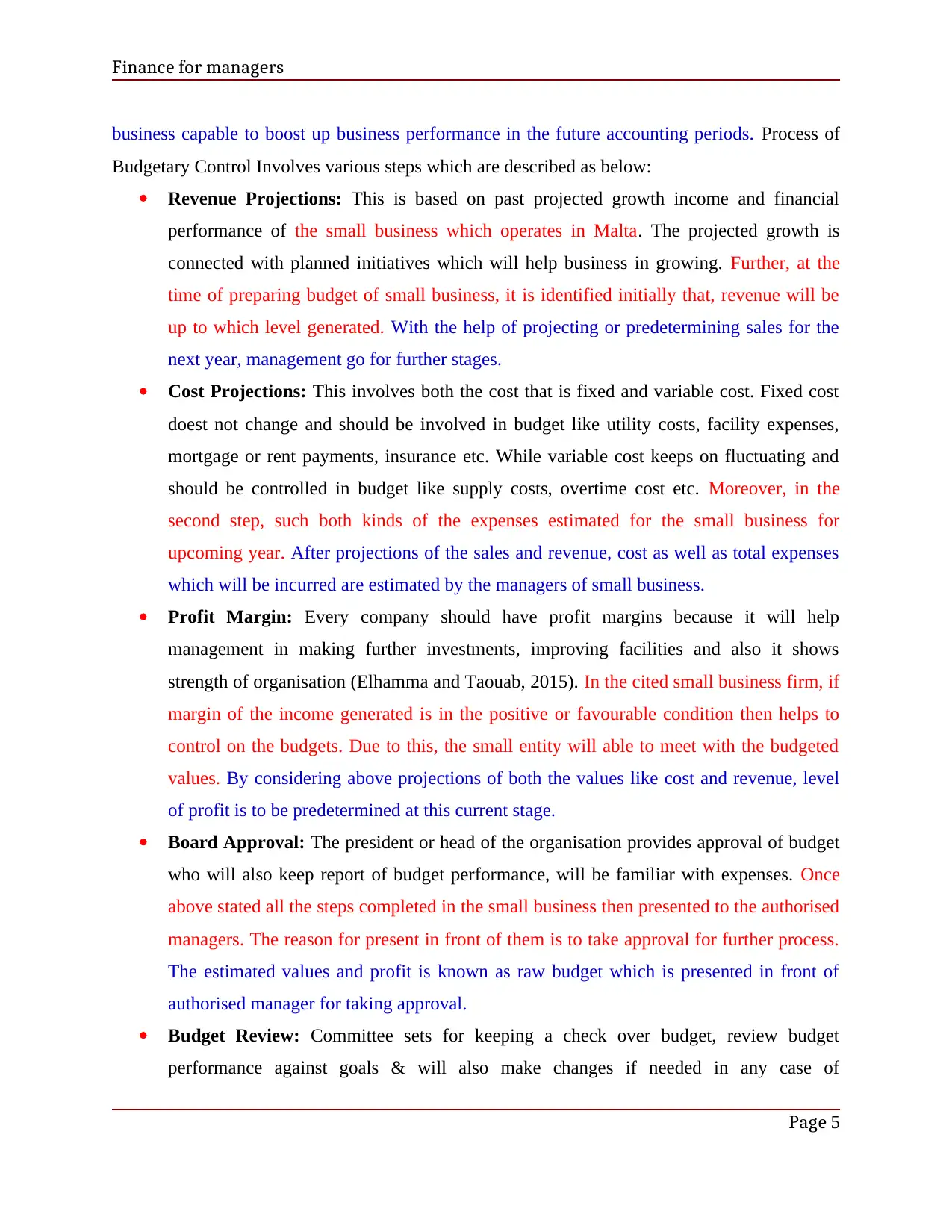
Finance for managers
business capable to boost up business performance in the future accounting periods. Process of
Budgetary Control Involves various steps which are described as below:
Revenue Projections: This is based on past projected growth income and financial
performance of the small business which operates in Malta. The projected growth is
connected with planned initiatives which will help business in growing. Further, at the
time of preparing budget of small business, it is identified initially that, revenue will be
up to which level generated. With the help of projecting or predetermining sales for the
next year, management go for further stages.
Cost Projections: This involves both the cost that is fixed and variable cost. Fixed cost
doest not change and should be involved in budget like utility costs, facility expenses,
mortgage or rent payments, insurance etc. While variable cost keeps on fluctuating and
should be controlled in budget like supply costs, overtime cost etc. Moreover, in the
second step, such both kinds of the expenses estimated for the small business for
upcoming year. After projections of the sales and revenue, cost as well as total expenses
which will be incurred are estimated by the managers of small business.
Profit Margin: Every company should have profit margins because it will help
management in making further investments, improving facilities and also it shows
strength of organisation (Elhamma and Taouab, 2015). In the cited small business firm, if
margin of the income generated is in the positive or favourable condition then helps to
control on the budgets. Due to this, the small entity will able to meet with the budgeted
values. By considering above projections of both the values like cost and revenue, level
of profit is to be predetermined at this current stage.
Board Approval: The president or head of the organisation provides approval of budget
who will also keep report of budget performance, will be familiar with expenses. Once
above stated all the steps completed in the small business then presented to the authorised
managers. The reason for present in front of them is to take approval for further process.
The estimated values and profit is known as raw budget which is presented in front of
authorised manager for taking approval.
Budget Review: Committee sets for keeping a check over budget, review budget
performance against goals & will also make changes if needed in any case of
Page 5
business capable to boost up business performance in the future accounting periods. Process of
Budgetary Control Involves various steps which are described as below:
Revenue Projections: This is based on past projected growth income and financial
performance of the small business which operates in Malta. The projected growth is
connected with planned initiatives which will help business in growing. Further, at the
time of preparing budget of small business, it is identified initially that, revenue will be
up to which level generated. With the help of projecting or predetermining sales for the
next year, management go for further stages.
Cost Projections: This involves both the cost that is fixed and variable cost. Fixed cost
doest not change and should be involved in budget like utility costs, facility expenses,
mortgage or rent payments, insurance etc. While variable cost keeps on fluctuating and
should be controlled in budget like supply costs, overtime cost etc. Moreover, in the
second step, such both kinds of the expenses estimated for the small business for
upcoming year. After projections of the sales and revenue, cost as well as total expenses
which will be incurred are estimated by the managers of small business.
Profit Margin: Every company should have profit margins because it will help
management in making further investments, improving facilities and also it shows
strength of organisation (Elhamma and Taouab, 2015). In the cited small business firm, if
margin of the income generated is in the positive or favourable condition then helps to
control on the budgets. Due to this, the small entity will able to meet with the budgeted
values. By considering above projections of both the values like cost and revenue, level
of profit is to be predetermined at this current stage.
Board Approval: The president or head of the organisation provides approval of budget
who will also keep report of budget performance, will be familiar with expenses. Once
above stated all the steps completed in the small business then presented to the authorised
managers. The reason for present in front of them is to take approval for further process.
The estimated values and profit is known as raw budget which is presented in front of
authorised manager for taking approval.
Budget Review: Committee sets for keeping a check over budget, review budget
performance against goals & will also make changes if needed in any case of
Page 5
Paraphrase This Document
Need a fresh take? Get an instant paraphrase of this document with our AI Paraphraser
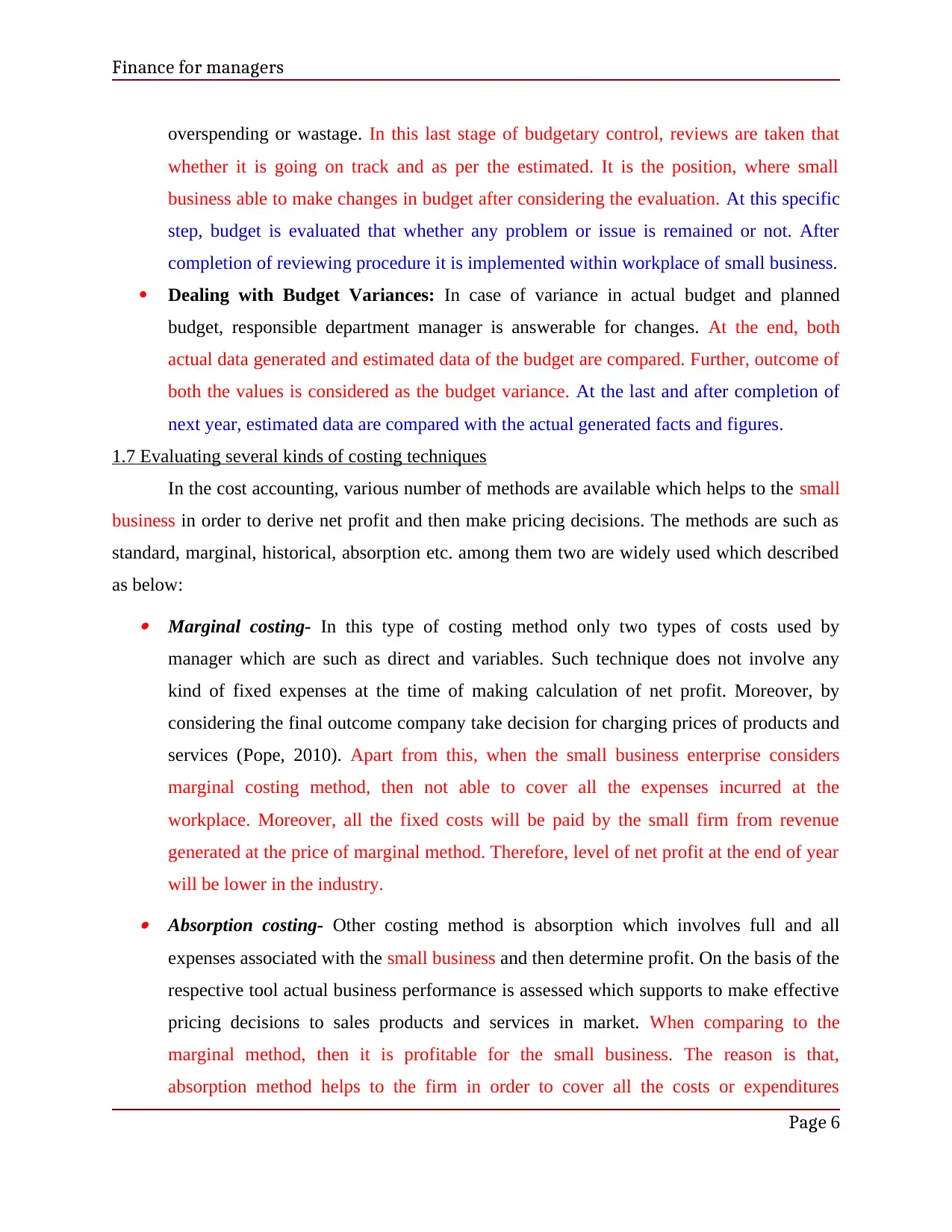
Finance for managers
overspending or wastage. In this last stage of budgetary control, reviews are taken that
whether it is going on track and as per the estimated. It is the position, where small
business able to make changes in budget after considering the evaluation. At this specific
step, budget is evaluated that whether any problem or issue is remained or not. After
completion of reviewing procedure it is implemented within workplace of small business.
Dealing with Budget Variances: In case of variance in actual budget and planned
budget, responsible department manager is answerable for changes. At the end, both
actual data generated and estimated data of the budget are compared. Further, outcome of
both the values is considered as the budget variance. At the last and after completion of
next year, estimated data are compared with the actual generated facts and figures.
1.7 Evaluating several kinds of costing techniques
In the cost accounting, various number of methods are available which helps to the small
business in order to derive net profit and then make pricing decisions. The methods are such as
standard, marginal, historical, absorption etc. among them two are widely used which described
as below: Marginal costing- In this type of costing method only two types of costs used by
manager which are such as direct and variables. Such technique does not involve any
kind of fixed expenses at the time of making calculation of net profit. Moreover, by
considering the final outcome company take decision for charging prices of products and
services (Pope, 2010). Apart from this, when the small business enterprise considers
marginal costing method, then not able to cover all the expenses incurred at the
workplace. Moreover, all the fixed costs will be paid by the small firm from revenue
generated at the price of marginal method. Therefore, level of net profit at the end of year
will be lower in the industry. Absorption costing- Other costing method is absorption which involves full and all
expenses associated with the small business and then determine profit. On the basis of the
respective tool actual business performance is assessed which supports to make effective
pricing decisions to sales products and services in market. When comparing to the
marginal method, then it is profitable for the small business. The reason is that,
absorption method helps to the firm in order to cover all the costs or expenditures
Page 6
overspending or wastage. In this last stage of budgetary control, reviews are taken that
whether it is going on track and as per the estimated. It is the position, where small
business able to make changes in budget after considering the evaluation. At this specific
step, budget is evaluated that whether any problem or issue is remained or not. After
completion of reviewing procedure it is implemented within workplace of small business.
Dealing with Budget Variances: In case of variance in actual budget and planned
budget, responsible department manager is answerable for changes. At the end, both
actual data generated and estimated data of the budget are compared. Further, outcome of
both the values is considered as the budget variance. At the last and after completion of
next year, estimated data are compared with the actual generated facts and figures.
1.7 Evaluating several kinds of costing techniques
In the cost accounting, various number of methods are available which helps to the small
business in order to derive net profit and then make pricing decisions. The methods are such as
standard, marginal, historical, absorption etc. among them two are widely used which described
as below: Marginal costing- In this type of costing method only two types of costs used by
manager which are such as direct and variables. Such technique does not involve any
kind of fixed expenses at the time of making calculation of net profit. Moreover, by
considering the final outcome company take decision for charging prices of products and
services (Pope, 2010). Apart from this, when the small business enterprise considers
marginal costing method, then not able to cover all the expenses incurred at the
workplace. Moreover, all the fixed costs will be paid by the small firm from revenue
generated at the price of marginal method. Therefore, level of net profit at the end of year
will be lower in the industry. Absorption costing- Other costing method is absorption which involves full and all
expenses associated with the small business and then determine profit. On the basis of the
respective tool actual business performance is assessed which supports to make effective
pricing decisions to sales products and services in market. When comparing to the
marginal method, then it is profitable for the small business. The reason is that,
absorption method helps to the firm in order to cover all the costs or expenditures
Page 6
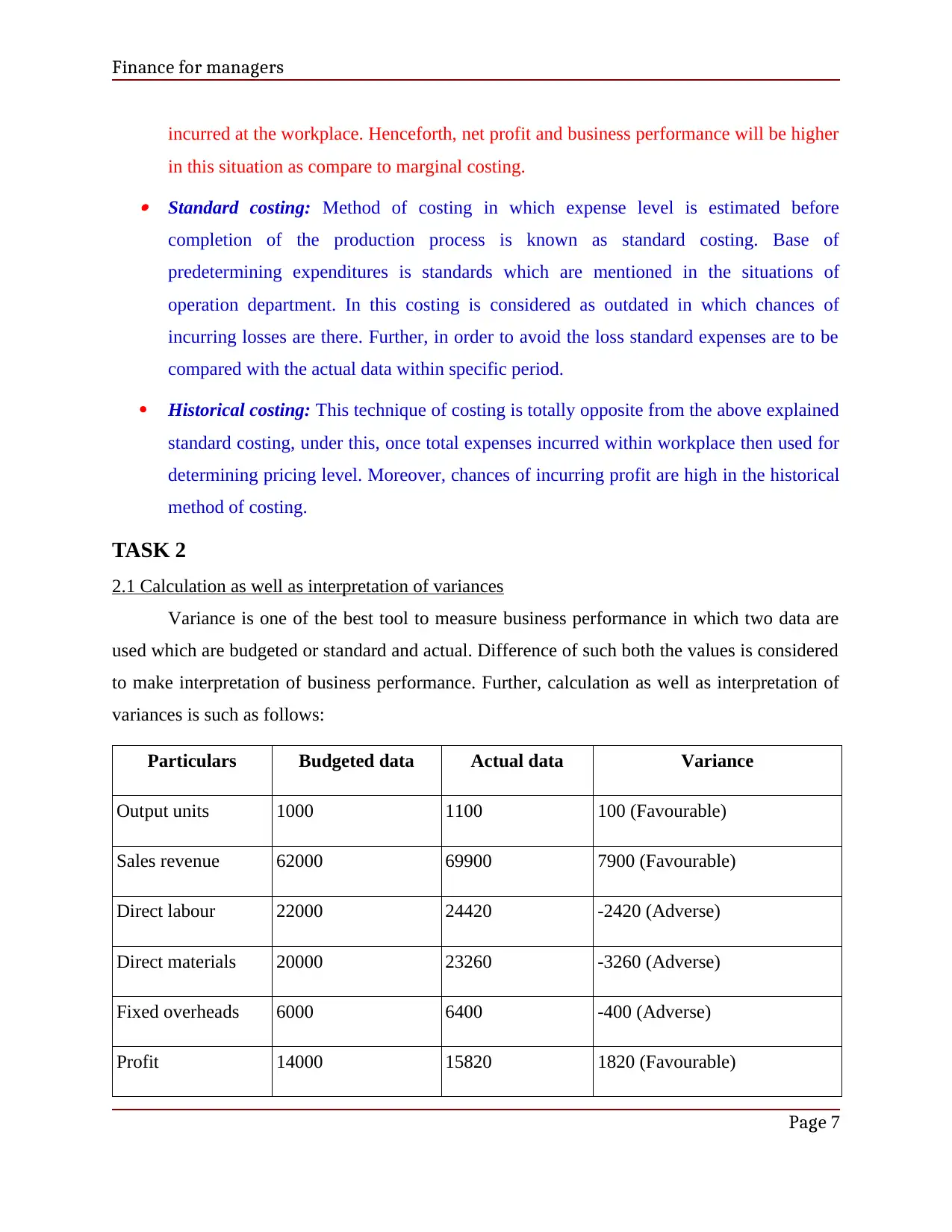
Finance for managers
incurred at the workplace. Henceforth, net profit and business performance will be higher
in this situation as compare to marginal costing. Standard costing: Method of costing in which expense level is estimated before
completion of the production process is known as standard costing. Base of
predetermining expenditures is standards which are mentioned in the situations of
operation department. In this costing is considered as outdated in which chances of
incurring losses are there. Further, in order to avoid the loss standard expenses are to be
compared with the actual data within specific period.
Historical costing: This technique of costing is totally opposite from the above explained
standard costing, under this, once total expenses incurred within workplace then used for
determining pricing level. Moreover, chances of incurring profit are high in the historical
method of costing.
TASK 2
2.1 Calculation as well as interpretation of variances
Variance is one of the best tool to measure business performance in which two data are
used which are budgeted or standard and actual. Difference of such both the values is considered
to make interpretation of business performance. Further, calculation as well as interpretation of
variances is such as follows:
Particulars Budgeted data Actual data Variance
Output units 1000 1100 100 (Favourable)
Sales revenue 62000 69900 7900 (Favourable)
Direct labour 22000 24420 -2420 (Adverse)
Direct materials 20000 23260 -3260 (Adverse)
Fixed overheads 6000 6400 -400 (Adverse)
Profit 14000 15820 1820 (Favourable)
Page 7
incurred at the workplace. Henceforth, net profit and business performance will be higher
in this situation as compare to marginal costing. Standard costing: Method of costing in which expense level is estimated before
completion of the production process is known as standard costing. Base of
predetermining expenditures is standards which are mentioned in the situations of
operation department. In this costing is considered as outdated in which chances of
incurring losses are there. Further, in order to avoid the loss standard expenses are to be
compared with the actual data within specific period.
Historical costing: This technique of costing is totally opposite from the above explained
standard costing, under this, once total expenses incurred within workplace then used for
determining pricing level. Moreover, chances of incurring profit are high in the historical
method of costing.
TASK 2
2.1 Calculation as well as interpretation of variances
Variance is one of the best tool to measure business performance in which two data are
used which are budgeted or standard and actual. Difference of such both the values is considered
to make interpretation of business performance. Further, calculation as well as interpretation of
variances is such as follows:
Particulars Budgeted data Actual data Variance
Output units 1000 1100 100 (Favourable)
Sales revenue 62000 69900 7900 (Favourable)
Direct labour 22000 24420 -2420 (Adverse)
Direct materials 20000 23260 -3260 (Adverse)
Fixed overheads 6000 6400 -400 (Adverse)
Profit 14000 15820 1820 (Favourable)
Page 7
⊘ This is a preview!⊘
Do you want full access?
Subscribe today to unlock all pages.

Trusted by 1+ million students worldwide
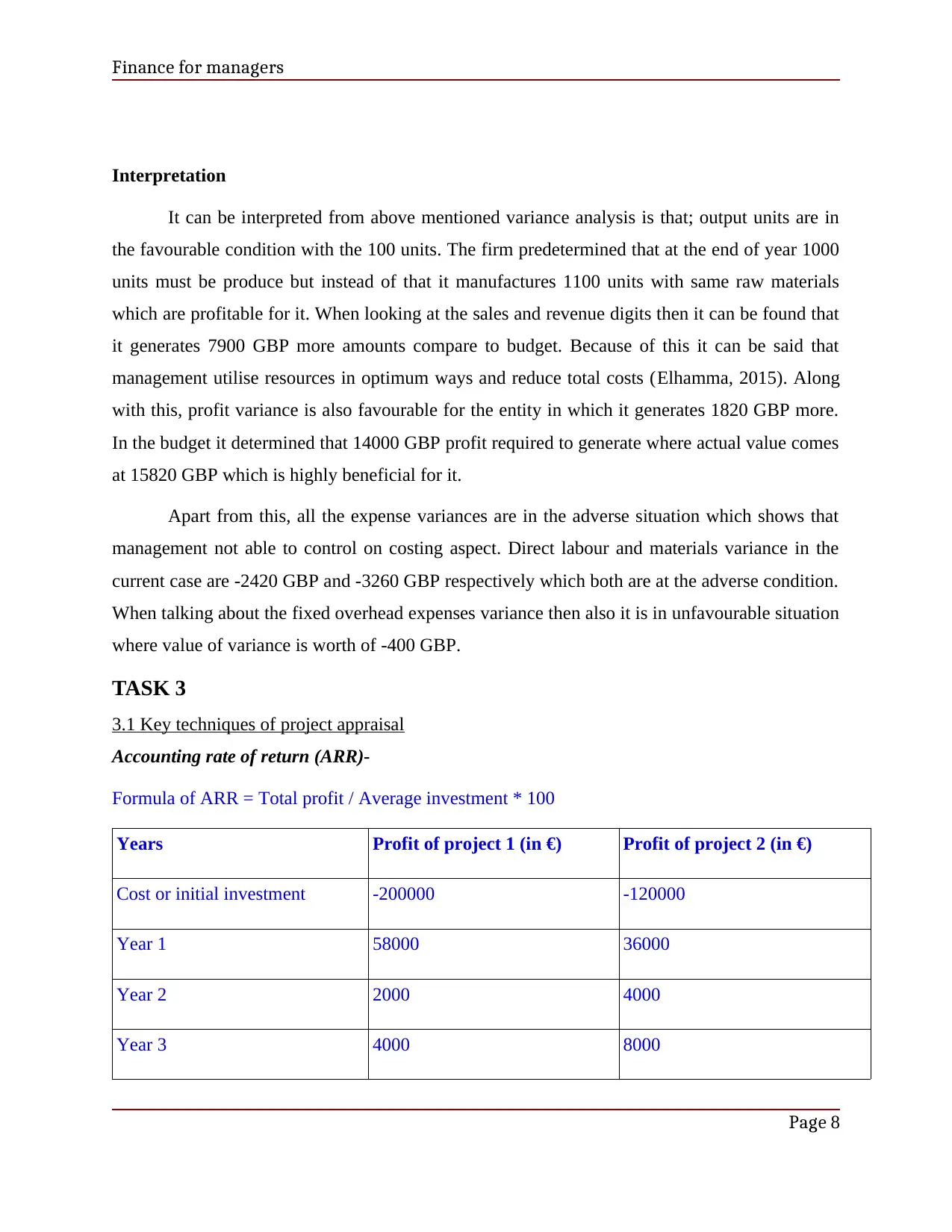
Finance for managers
Interpretation
It can be interpreted from above mentioned variance analysis is that; output units are in
the favourable condition with the 100 units. The firm predetermined that at the end of year 1000
units must be produce but instead of that it manufactures 1100 units with same raw materials
which are profitable for it. When looking at the sales and revenue digits then it can be found that
it generates 7900 GBP more amounts compare to budget. Because of this it can be said that
management utilise resources in optimum ways and reduce total costs (Elhamma, 2015). Along
with this, profit variance is also favourable for the entity in which it generates 1820 GBP more.
In the budget it determined that 14000 GBP profit required to generate where actual value comes
at 15820 GBP which is highly beneficial for it.
Apart from this, all the expense variances are in the adverse situation which shows that
management not able to control on costing aspect. Direct labour and materials variance in the
current case are -2420 GBP and -3260 GBP respectively which both are at the adverse condition.
When talking about the fixed overhead expenses variance then also it is in unfavourable situation
where value of variance is worth of -400 GBP.
TASK 3
3.1 Key techniques of project appraisal
Accounting rate of return (ARR)-
Formula of ARR = Total profit / Average investment * 100
Years Profit of project 1 (in €) Profit of project 2 (in €)
Cost or initial investment -200000 -120000
Year 1 58000 36000
Year 2 2000 4000
Year 3 4000 8000
Page 8
Interpretation
It can be interpreted from above mentioned variance analysis is that; output units are in
the favourable condition with the 100 units. The firm predetermined that at the end of year 1000
units must be produce but instead of that it manufactures 1100 units with same raw materials
which are profitable for it. When looking at the sales and revenue digits then it can be found that
it generates 7900 GBP more amounts compare to budget. Because of this it can be said that
management utilise resources in optimum ways and reduce total costs (Elhamma, 2015). Along
with this, profit variance is also favourable for the entity in which it generates 1820 GBP more.
In the budget it determined that 14000 GBP profit required to generate where actual value comes
at 15820 GBP which is highly beneficial for it.
Apart from this, all the expense variances are in the adverse situation which shows that
management not able to control on costing aspect. Direct labour and materials variance in the
current case are -2420 GBP and -3260 GBP respectively which both are at the adverse condition.
When talking about the fixed overhead expenses variance then also it is in unfavourable situation
where value of variance is worth of -400 GBP.
TASK 3
3.1 Key techniques of project appraisal
Accounting rate of return (ARR)-
Formula of ARR = Total profit / Average investment * 100
Years Profit of project 1 (in €) Profit of project 2 (in €)
Cost or initial investment -200000 -120000
Year 1 58000 36000
Year 2 2000 4000
Year 3 4000 8000
Page 8
Paraphrase This Document
Need a fresh take? Get an instant paraphrase of this document with our AI Paraphraser
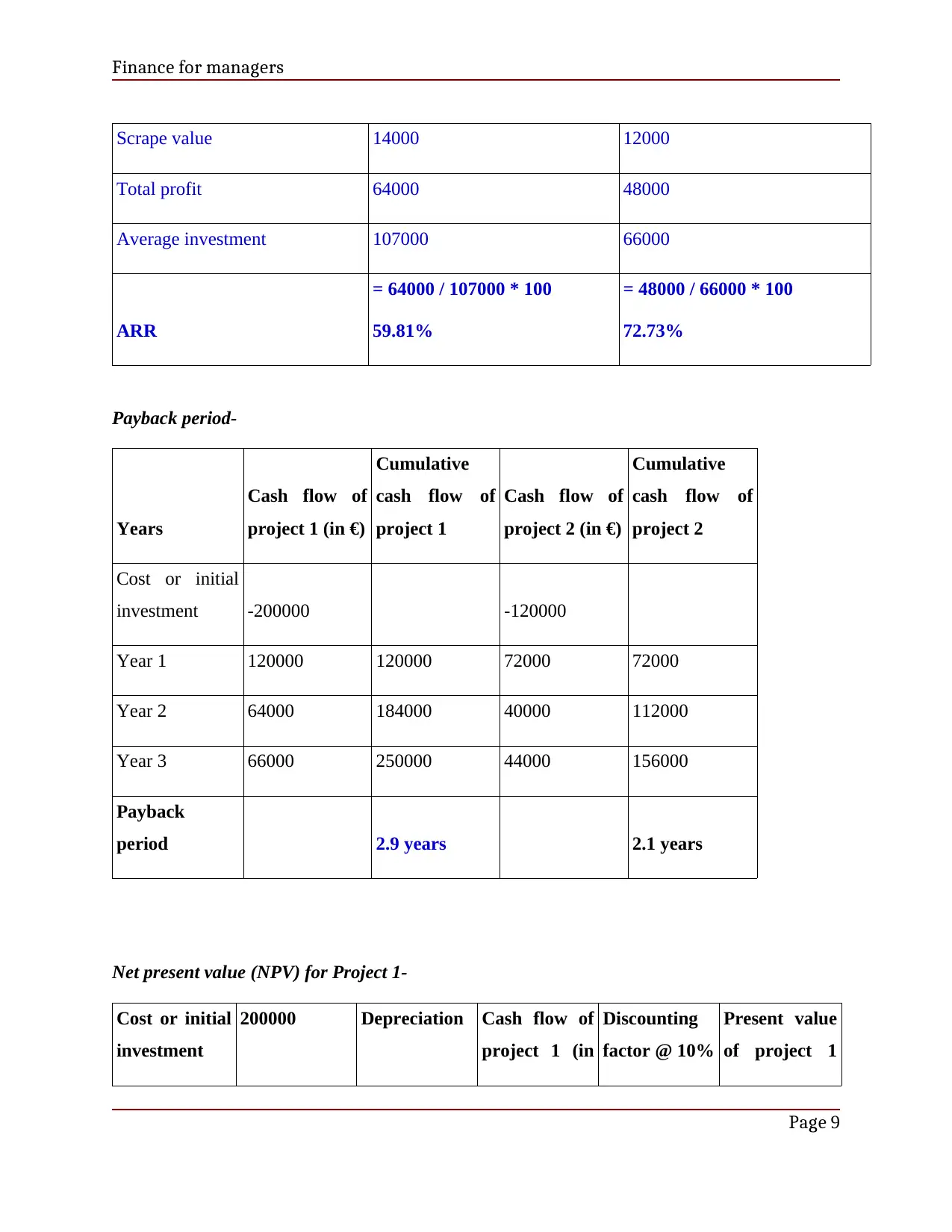
Finance for managers
Scrape value 14000 12000
Total profit 64000 48000
Average investment 107000 66000
ARR
= 64000 / 107000 * 100
59.81%
= 48000 / 66000 * 100
72.73%
Payback period-
Years
Cash flow of
project 1 (in €)
Cumulative
cash flow of
project 1
Cash flow of
project 2 (in €)
Cumulative
cash flow of
project 2
Cost or initial
investment -200000 -120000
Year 1 120000 120000 72000 72000
Year 2 64000 184000 40000 112000
Year 3 66000 250000 44000 156000
Payback
period 2.9 years 2.1 years
Net present value (NPV) for Project 1-
Cost or initial
investment
200000 Depreciation Cash flow of
project 1 (in
Discounting
factor @ 10%
Present value
of project 1
Page 9
Scrape value 14000 12000
Total profit 64000 48000
Average investment 107000 66000
ARR
= 64000 / 107000 * 100
59.81%
= 48000 / 66000 * 100
72.73%
Payback period-
Years
Cash flow of
project 1 (in €)
Cumulative
cash flow of
project 1
Cash flow of
project 2 (in €)
Cumulative
cash flow of
project 2
Cost or initial
investment -200000 -120000
Year 1 120000 120000 72000 72000
Year 2 64000 184000 40000 112000
Year 3 66000 250000 44000 156000
Payback
period 2.9 years 2.1 years
Net present value (NPV) for Project 1-
Cost or initial
investment
200000 Depreciation Cash flow of
project 1 (in
Discounting
factor @ 10%
Present value
of project 1
Page 9
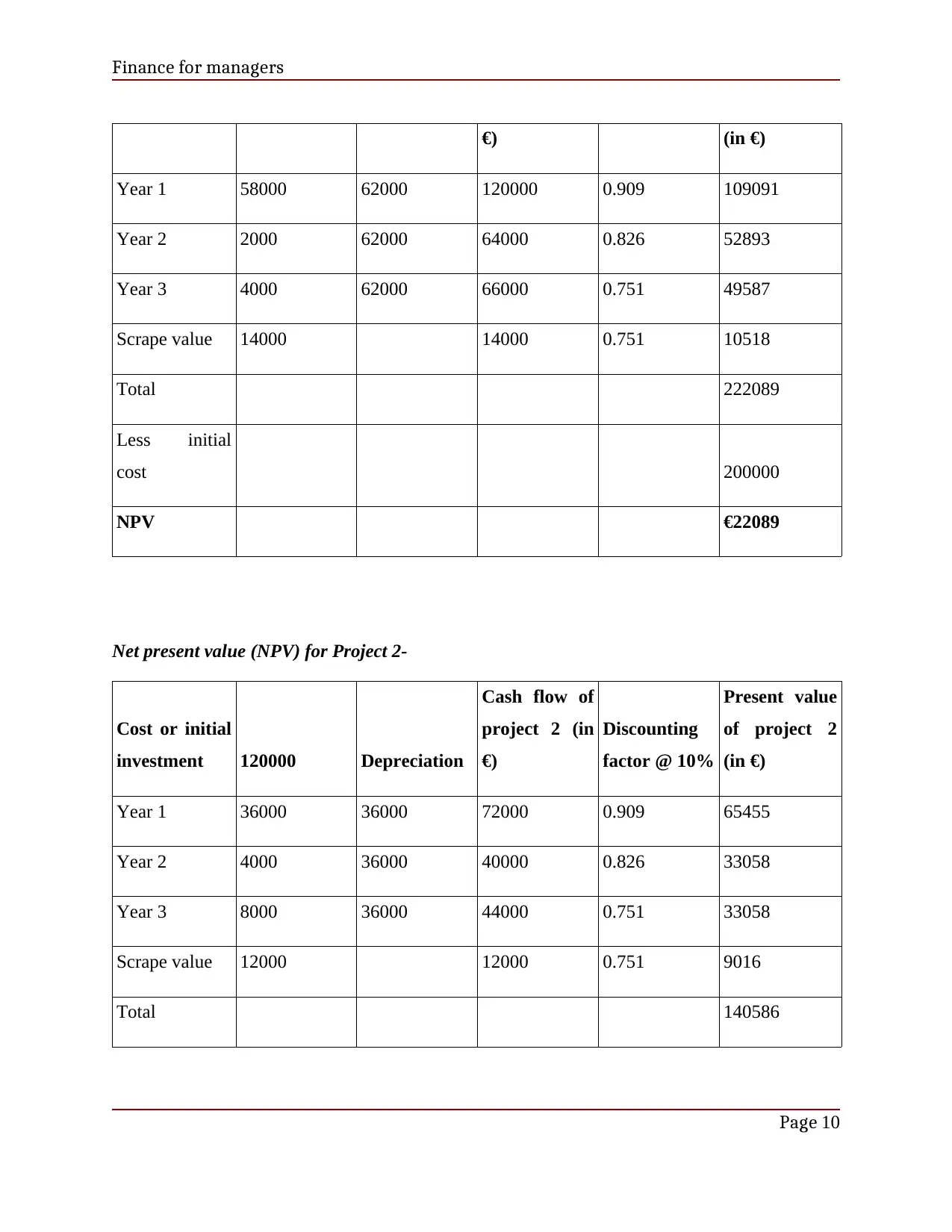
Finance for managers
€) (in €)
Year 1 58000 62000 120000 0.909 109091
Year 2 2000 62000 64000 0.826 52893
Year 3 4000 62000 66000 0.751 49587
Scrape value 14000 14000 0.751 10518
Total 222089
Less initial
cost 200000
NPV €22089
Net present value (NPV) for Project 2-
Cost or initial
investment 120000 Depreciation
Cash flow of
project 2 (in
€)
Discounting
factor @ 10%
Present value
of project 2
(in €)
Year 1 36000 36000 72000 0.909 65455
Year 2 4000 36000 40000 0.826 33058
Year 3 8000 36000 44000 0.751 33058
Scrape value 12000 12000 0.751 9016
Total 140586
Page 10
€) (in €)
Year 1 58000 62000 120000 0.909 109091
Year 2 2000 62000 64000 0.826 52893
Year 3 4000 62000 66000 0.751 49587
Scrape value 14000 14000 0.751 10518
Total 222089
Less initial
cost 200000
NPV €22089
Net present value (NPV) for Project 2-
Cost or initial
investment 120000 Depreciation
Cash flow of
project 2 (in
€)
Discounting
factor @ 10%
Present value
of project 2
(in €)
Year 1 36000 36000 72000 0.909 65455
Year 2 4000 36000 40000 0.826 33058
Year 3 8000 36000 44000 0.751 33058
Scrape value 12000 12000 0.751 9016
Total 140586
Page 10
⊘ This is a preview!⊘
Do you want full access?
Subscribe today to unlock all pages.

Trusted by 1+ million students worldwide
1 out of 19
Related Documents
Your All-in-One AI-Powered Toolkit for Academic Success.
+13062052269
info@desklib.com
Available 24*7 on WhatsApp / Email
![[object Object]](/_next/static/media/star-bottom.7253800d.svg)
Unlock your academic potential
Copyright © 2020–2025 A2Z Services. All Rights Reserved. Developed and managed by ZUCOL.





